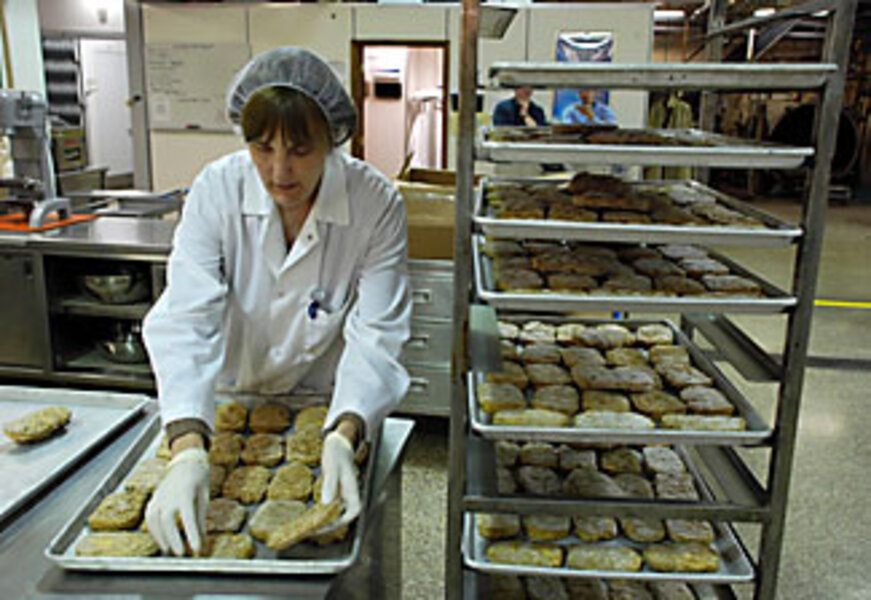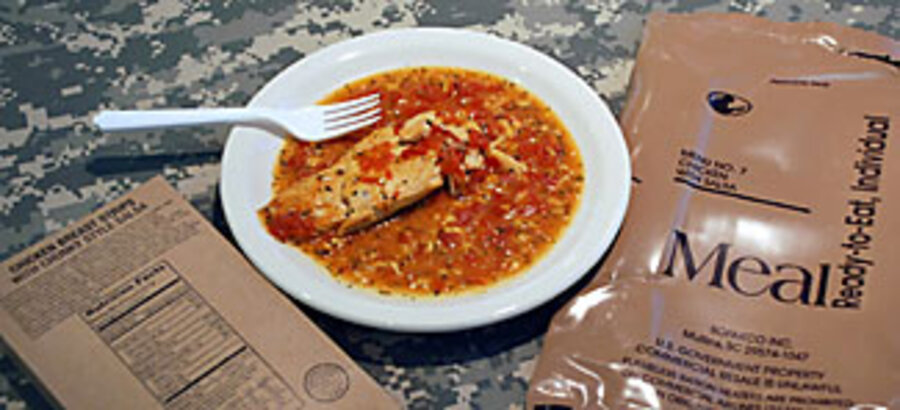Taste is on the agenda for military Meals Ready to Eat
Loading...
| Natick, Mass.
Like any chef, Jeanette Kennedy's palate has become so refined over the years that, given any dish, she can single out virtually every ingredient – the pinch of black pepper, the hint of oregano, or the vegetable oil subbing for olive oil.
On a recent morning she was testing a slab of pound cake, her face blank as she silenced her other senses and focused on taste and texture.
After a good long chew, Ms. Kennedy spit the cake into a paper cup – an indelicacy that was not a comment on the cake (which she deemed pretty good), but the result of a high calorie occupational hazard. This pound cake is no tea party trifle; it's combat cuisine – part of an MRE, Meal Ready to Eat – designed to fuel soldiers lugging 100-pound packs all day.
A food technologist at the US Army Natick Soldier Systems Center (NSSC) west of Boston, Kennedy faces creative challenges unlike those before any other chef. Meals can't just taste good; they've got to last ... for three years stored at 80 degrees F., be capable of withstanding chemical or biological attacks, and survive a 10-story free fall (when packed in a crate of 12).
In this world, making something as seemingly simple as a sandwich earns a food technologist rock star status, even if only within the confines of the lab.
• • •
Ask anyone who has worn a US military uniform and they'll have an opinion about rations. MREs – the name given to the rations first served in the 1980s when canned fare gave way to meals packed in sturdy beige pouches – have nicknames that pretty much sum up what many troops think: Meals Rejected by the Enemy, Meals Rarely Edible, and Meals Refusing to Exit (a name that continues to stick despite the addition of more fiber).
"You go into [your first MRE] with a preconceived notion, just from what you've heard from either your instructors or other people that you're in training with, that they're not good," says Jeremy Whitsitt, a former Army soldier and now program outreach coordinator at NSSC. "But I think a lot of that has to do with the early days of the MRE, and just with military rations in general. Over time they've kind of developed a bad reputation, because for a long period of time we weren't customer focused."
Considering the difficulties of the durability requirements, it's easy to see how taste and customer satisfaction were low priorities. The only reason MREs aren't supposed to be consumed after three years is because science hasn't found a way to stop the deterioration of taste. But technically – if not gustatorially – they're still edible long after the expiration date.
But, Jill St. Jean, who ate a 6- or 7-year-old MRE beef patty during her training to become a certified MRE taste test evaluator at NSSC, admits, "That one pretty much tasted like dog food smells."
In years past, the canned C-rations that served the military from World War II through Vietnam actually looked a lot like wet dog food, which is also how many soldiers remember the taste. But these rations came from a very different time, an era when cigarettes were still standard issue.
Today, troop acceptance of the meals, which cost the military $7.13 each, has taken center stage. Back in 1982 when MREs debuted, designers assumed they could hang up their aprons. But when the first Gulf War broke out, the new ration moved from limited training use to the only food soldiers ate for months on end. Angry letters flooded in from the trenches, and the military realized that rations had to be a work in progress.
Now food technologists conduct focus groups with troops across the country, follow restaurant fads, and even attend culinary school to make sure their approach isn't entirely scientific.
"[MREs] really go along with the trends," says Kennedy. "As new things come out at restaurants, new flavors like chipotle or buffalo [get popular], they get incorporated into the MRE.... The trend [now is] going to more comfort foods like Salisbury steak, beef briquette, but it's not just macaroni and cheese, it's Mexican macaroni and cheese."
Just as in the first Gulf War, when NSSC misses the mark today, soldiers in the field let them know. After living off nothing but MREs for 45 days in Afghanistan, Spc. Colin Hankinson wrote a letter that included samples of packaging from Canadian rations that offered troops customer feedback cards with every meal
He also suggested that MRE designers "expunge" Cinnamon Imperial candies from the ration. "They are not satisfying to eat or useful to trade," explains Specialist Hankinson. "During the past 45-day mission, the primary consumers of Cinnamon Imperials were Afghan children and the burn pit."
Since 1993, NSSC has tried to avoid letters like Hankinson's by creating more than 189 new MRE menu items, almost 12 per year.
• • •
The kitchen lab where Kennedy and a number of other food technologists whip up the latest MRE dishes resembles a cross between a school cafeteria kitchen and a third world operating room. There are walk-in freezers, multiple meat slicers, a retorting machine bigger than a mid-size car, and lab coats and hair nets (for both head and facial hair) are required.
It was in this kitchen that Kennedy dreamed up what she considers her tastiest creation: a spicy vegetarian penne pasta. Mixed with a soy-based, non-meat sausage crumble, the pasta is covered with a zesty sauce that Kennedy says has "kick."
Asked to describe the inspiration for the penne platoon-pleaser, she ponders a moment before responding, "Well, I can't really say there was an inspiration."
Quite simply, she was under military orders to create a new vegetarian dinner with a protein source. Beyond that, she was like Michelangelo with a chisel and a slab of marble, limited only by her imagination.
The new emphasis on customer satisfaction has made it an exciting time to be a food technologist. In many ways, it's even led to rethinking the MRE.
Take the new First Strike Ration (FSR) for example. It's meant to provide service men and women with snacks throughout the day that add up to the equivalent of three square MREs. Since the FSR is intended for soldiers on the march, and not in a position to easily prepare food, it was what ultimately inspired the creation of the three-year sandwich – currently barbecue beef or chicken and Italian sausage, among others.
Though it might seem a minor innovation, for food technologists it was a breakthrough. Previously, finding a way to stop wet ingredients like BBQ sauce smothered chicken from seeping into the bread was impossible. But through tinkering with chemicals in the wet center. they managed a a long-life rendition of a sandwich resembling a Pop-Tart).
After clearing the sandwich hurdle, Michelle Richardson, a food technologist for 19 years, looks forward to overcoming the next MRE conquest: eggs.
"Now I'm trying to give [troops] a breakfast burrito, the same thing you can get at McDonald's but doesn't require any refrigeration and is shelf stable for two years," she says. "Egg is really kind of difficult [to preserve], but that's OK. I like a challenge and I don't get bored."
• Watch 10-year-old taste testers issue their verdict on MREs.






